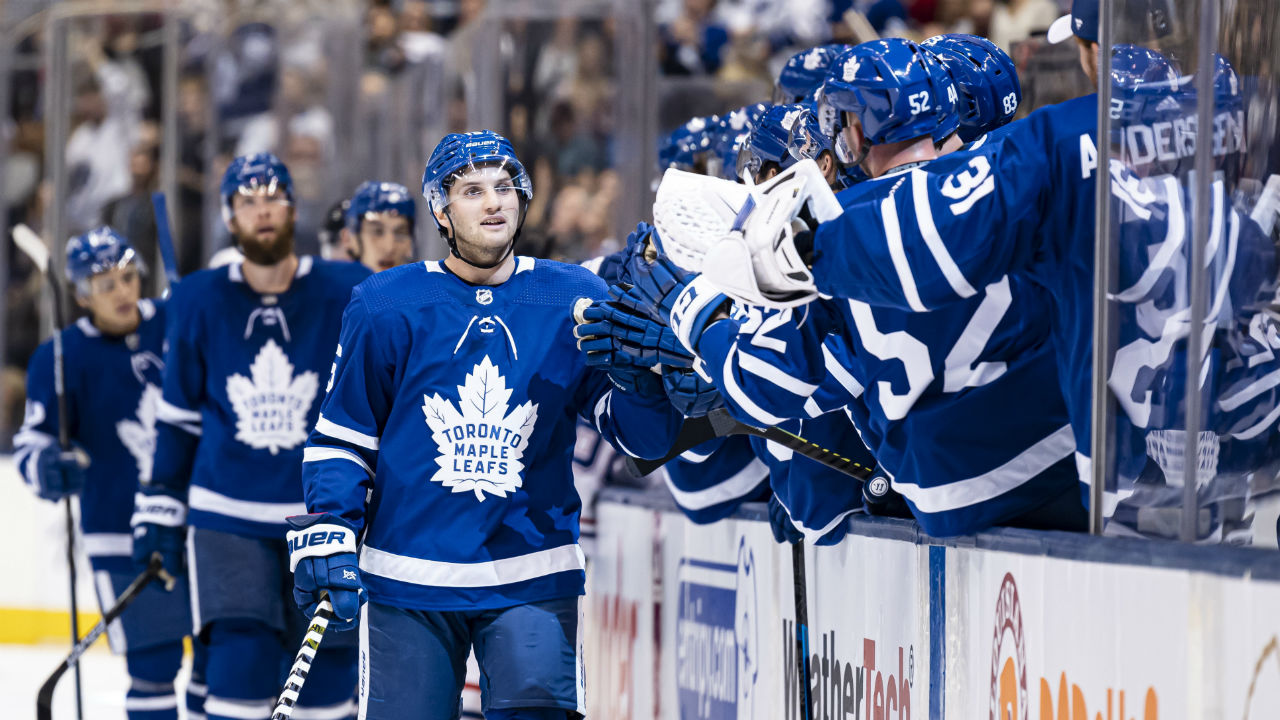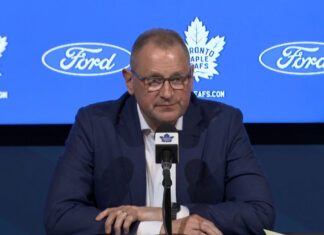No surprise to fans of this team who weren’t born yesterday, the Maple Leafs’ decision to protect eight skaters and a goalie while leaving both Jared McCann and Alex Kerfoot exposed has been a subject of intense scrutiny in Leafs Nation over the last 24 hours.
I want to start with a pair of facts that should be obvious but need to be spelled out clearly nonetheless:
1. Saturday’s Hallander-for-McCann trade only happens in the context of the expansion-draft pressures facing Pittsburgh — the Leafs are not getting him so cheaply at any other time — and it has to occur before 3 p.m. on July 17.
2. You are always losing an NHL asset to Seattle no matter what.
With the Jared McCann trade available to Kyle Dubas, before he pulled the trigger on the deal and then submitted his protection list on Saturday, here were the possible outcomes under the eight skaters, one goalie protection scheme, with the team’s top four on defense (Morgan Rielly, TJ Brodie, Jake Muzzin, Justin Holl) all protected:
1. The Leafs lose Hallander, but they keep Kerfoot and Dermott. For now, their cap situation for 2021-22 remains the same.
2. The Leafs lose Kerfoot, but they’ve now officially converted Hallander into McCann (on paper, a more offensively productive replacement for Kerfoot) while also keeping Dermott. They gain $560,000 in cap space for 2021-22 and free up $3.5 million in 2022-23 (McCann is an RFA in 2022).
3. The Leafs lose Dermott, but they convert Hallander into McCann and keep Kerfoot. Your cap commitment for 2021-22, after subtracting Dermott and adding McCann, increases by $1.44 million.
Here were the possible outcomes under the 7-3-1 protection scheme with Justin Holl and Travis Dermott exposed:
4. The Leafs lose Holl and Hallander, but they keep all of Dermott, McCann, and Kerfoot instead of losing one of the three. Their cap commitment for 2021-22 rises by $940,000 (for now) with all of Dermott, McCann, and Kerfoot on the roster and Holl departed.
5. The Leafs lose Dermott and Hollander, but they keep all of Holl, McCann, and Kerfoot instead of losing one of the three. Their cap commitment increases by $1.44 million in 2021-22.
Note: I am not including the 2023 seventh-round pick above because it has virtually no value.
It is clear that there is no scenario, from an asset management point of view, that is not improved by pulling the trigger on the Hallander for McCann deal.
Where there is room for debate is whether scenario 4 or 5 is superior to scenarios 1-3. Should the Leafs have pivoted to a 7-3-1 protection scheme, and lost, in all likelihood, Justin Holl to Seattle?
Firstly, there is nothing in the system that Dubas can reasonably bet on to replace Holl’s minutes for 2021-22. It’s only Timothy Liljegren of 13 NHL GP, or shifting Travis Dermott to the right side full time and having him play top-four shutdown minutes next to Muzzin. In my view, these are unpalatable gambles for a Leafs defense core that was finally pretty much set-and-forget and basically worry-free (barring a few mixed stretches from Rielly-Brodie) throughout 2020-21.
In terms of an external solution, Dubas’ calculation is that the likely cost of what the Leafs would have had to pay in cap dollars to replace Holl in his current role — not to mention there could be an additional acquisition cost should they need to trade for this right-side replacement — would not make for shrewd asset management.
Therefore, he chose to go with one of the first three options in order to avoid scenario 4. I personally find this to be completely sound decision-making based on the information we have in front in front of us today.
Others may see a FA option out there that Dubas could sign in the neighborhood of $2-3 million to partner effectively with Jake Muzzin, but I am not convinced this player is available, and there is a valid bird-in-hand argument that applies here. It’s not easy to find mobile right-handed NHL defensemen with size who are known quantities to the coach, fit the system, can defend pretty well, kill penalties, move the puck just fine, chip in .35 points per game without power-play time, and have established chemistry with your most important 5v5 defenseman (Muzzin). Not affordably under the Leafs’ cap constraints, anyway.
Holl’s 5v5 results next to Muzzin were very strong this past season. Under tough assignments, they broke even in shot attempts, owned 53% of the shots on goal, 55.6% of the expected goals, and outscored the opposition 42-30. They started just 46.8% of their shifts in the offensive zone, by far the lowest of the Leafs’ three regular pairings. Holl may not be able to buoy a top-four pairing apart from a partner as strong as Muzzin, but going back to their 2019-20 numbers (which were also good), Holl complements him well and he is signed for $2 million AAV for two more seasons.
There could be an argument made for losing Holl and moving Brodie next to Muzzin in the shutdown role — which had great results in very limited minutes — but now you’re back to the age-old dilemma of finding the right partner for Morgan Rielly, and the answer is probably not available internally as early as this Fall.
All of this headache would be incurred in order to keep a middle-six winger/center in Kerfoot or McCann who are paid $3-3.5 million to play about 14-15 minutes a game and produce between 35-45 points based on their career averages. Both are decent players — McCann offers more offensive upside, particularly with his shot — but they are not difficult players to replace if Dubas is doing his job well. In fact, there should be more value to be squeezed out of $3.5 million than what Kerfoot has been providing with his regular-season contributions.
There has been a common criticism that Dubas may have given up Hallander for a player who is going to be lost to Seattle for nothing anyway. Again, keep in mind that you’re always losing an asset. In this light, giving up Hallander instead of Kerfoot is clearly sound asset management if this scenario were to play out. In an alternative scenario, giving up Kerfoot and having a more productive replacement at the ready for $500k less on the cap and at the price of Hallander in Jared McCann is also sound asset management.
It’s perhaps debatable whether or not, in a scenario where McCann or Dermott leaves and Kerfoot remains, Kerfoot could fetch much value at $3.5 million given his regular-season production should the Leafs decide to move him this offseason (which, in my view, they should strongly consider). This is tough for us to know without having the conversations Dubas has had with rival GMs around the league over the past few weeks.
There is some reason to believe Kerfoot is a reasonably marketable asset coming off of a really strong playoff and knowing — more importantly — that if/when the Leafs pick up his signing bonus in a few days, he’ll be owed just $750k this season and just $3.45 million total over the final two years of his contract.
The consensus among insiders remains that Seattle is still likely to take Kerfoot. However, an interesting note from Frank Seravalli indicates that they may have wanted both McCann and Kerfoot prior to the trade between Pittsburgh and Toronto, leaving this as a bit of a tossup.
In either scenario, the Leafs are better off with Dubas having made the move for Jared McCann on Saturday.

































